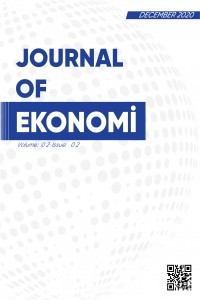The role of leadership in creating an organizational culture
Leadership, Organizational change, Organizational culture
The role of leadership in creating an organizational culture
___
- Akan, Y. and Isik, C. (2010). Human Resource Management: An Analysis of Strategic Approach. Lex ET Scientia Int'l J., 17, 318.
- Aronson E. (1989). The rationalizing animal. In H. Leavitt, L. Pondy &; D. Boje (eds.), Readings in Managerial Psychology, (pp 134-145), Chicago: The University of Chicago Press.
- Bennis, W. G. and Nanus, B. (1985). Leaders: The strategies for taking charge. New York: Harper & Row.
- Dandridge, T., Mitroff, I. and Joyce, W. (1980). Organizational Symbolism: A Topic To Expand Organizational Analysis. Academy of Management Review, 5(1): 77-82.
- Işık, C., Sirakaya-Turk, E. and Ongan, S. (2019). Testing the efficacy of the economic policy uncertainty index on tourism demand in USMCA: Theory and evidence. Tourism Economics, 1354816619888346.
- Işık, C., Günlü Küçükaltan, E., Kaygalak Çelebi, S., Çalkın, Ö., Enser, İ. and Çelik, A. (2019a) Tourism and entrepreneurship: A literature review. Journal of Ekonomi, 1 (1): 1-27.
- Işık, C., Günlü Küçükaltan, E., Taş, S., Akoğul, E., Uyrun, A., Hajiyeva, T., Turan, B., Dırbo, A. and Bayraktaroğlu, E. (2019b) Tourism and innovation: A literature review. Journal of Ekonomi, 1 (2): 98-154.
- Isik, C., Dogru, T., and Turk, E. S. (2018). A nexus of linear and non‐linear relationships between tourism demand, renewable energy consumption, and economic growth: Theory and evidence. International Journal of Tourism Research, 20(1): 38-49.
- Işık, C. ve Aydın, E. (2017). Kişisel değerlerin sosyal girişimcilik eğilimine etkisi: Turizm öğrencileri üzerine bir araştırma. Girişimcilik ve İnovasyon Yönetimi Dergisi, 6(2): 131-154.
- Işık, C., Tirak, L., ve Işık, Z., (2016). Potansiyel kadın turizmcilerin girişimcilik ve inovasyon eğilimlerinin belirlenmesi. Ekonomi, Yönetim ve Sosyal Araştırmalar Dergisi, 1(1): 31-44.
- Işık, C., & Aydın, E. (2016a). Bilgi paylaşımının yenilikçi iş davranışına etkisi: Ayder Yaylası konaklama işletmeleri üzerine bir uygulama. Girişimcilik ve İnovasyon Yönetimi Dergisi, 5(2): 75-103.
- Işık, C. and Aydın, E. (2016b). Konaklama işletmeleri çalışanlarının yenilikçi iş davranışı düzeylerinin incelenmesi: Ayder Yaylası örneği. Ekonomi, Yönetim ve Sosyal Araştırmalar Dergisi, 1(1): 17-30.
- Martin, J. (2002). Organizational Culture: Mapping the Terrain. London: Sage.] [Frost PJ, Moore LF, Louis MR, Lundberg CC, &; Martin (1991). Reframing organizational culture. ence, vol. 18, pp. 257–273.
- Pondy, P. Frost, Morgan, G, and Dandridge, T. (eds) Organizational symbolism, (pp. 55 - 65), Greenwich, CT: JAI.] [Smircich L., &; Morgan G. (1982). Leadership: The Management of Meaning, Journal of Applied Behavioral Sci.
- Sarros, J. C., Gray J. and Densten, I. L. (2002). Leadership and Its Impact On Organizational Culture, International Journal Of Business Studies, 10(2): 1-26.
- Schein E. (2004). Organizational culture and leadership. Thousand Oaks: Sage Schermerhorn et al., 2010, p. 306 According to House and his associates House et al., 1999, p. 184.
- Schermerhorn, J. R., Hunt, J. G., Osborn, R. N. and Uhl-Bien, M. (2010). Organizational Behavior: John Wiley & Sons.
- Schriesheim, C. A. and Neider, L. L. (1996). Path-goal leadership theory: The long and winding road. Leadership Quarterly, 7(3): 317.
- Schriesheim, C. A., Castro, S. L., Zhou, X., & DeChurch, L. A. (2006). An investigation of path-goal and transformational leadership theory predictions at the individual level of analysis. The Leadership Quarterly, 17(1): 21-38. doi: 10.1016/j.leaqua.2005.10.008.
- Yayın Aralığı: Yılda 2 Sayı
- Başlangıç: 2019
- Yayıncı: Cem IŞIK
A research on the perceptions of cotton producers to form a producers’ union in Şanlıurfa - Turkey
Mustafa Hakkı AYDOĞDU, Mehmet Reşit SEVİNÇ, Mehmet CANÇELİK
The relationship between foreign exchange rate, interest rate and inflation in Turkey: ARDL approach
Developments and practices in the social security system in England
The financial and conceptual foundations of intangible asset manager capitalism
The role of leadership in creating an organizational culture
The role of the sports economy in the United Arab Emirates
